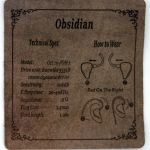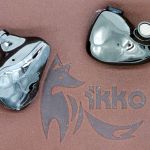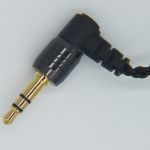
IKKO Obsidian OH10 Review: Subtle yet big
With the well-praised Meteor OH1 that came out of the blue, IKKO is one of the fastest-growing brands in the IEM market. Perhaps I can't really say that they've come out of nowhere since they are known to be doing R&D businesses for a while now.
Meteor OH1 was previously reviewed here in About Audio and that IEM left me very good impressions for its high-quality build and sound with an affordable price tag of $139. Obsidian OH10 is their second product that continues that trend with a price of $189, yet with some bold upgrades. Along with some comparisons with the original Meteor OH1 (Meteor in short), let's take a close look at the key features and sound from the Obsidian OH10 (Obsidian in short).


Packaging
Obsidian comes in with a nice packaging with sensual design and accessories. Other than the earpieces, it includes a 3.5mm stock cable, a leather pouch, 3 pairs of black eartips, 3 pairs of white eartips, a shirt pin, and a warranty card. It would be better to see a hard case for better protection (especially since these are 2pin earphones), but the included leather pouch is high in quality and convenience. Two different types of silicone tips pose slightly different signatures, the darker one with more energetic and denser sound and the lighter one with a more opened and relaxed sound.

Earpieces
Obsidian sports a 1BA+1DD hybrid design by using 10mm titanium-plated polymer composite diaphragm with a Knowles 33518 BA driver. It might have been unexpected for Obsidian to have the same driver configuration as the Meteor, but always gotta remember driver numbers don't matter in sound. Obsidian is worn over-ear and has an ergonomic, hassle-free design. The nozzles are on the shorter side but provide a proper seal and insertion. The diameter of the nozzles is around T400-500 which makes it compatible with most aftermarket eartips. The connectors are terminated in non-recessed 0.78mm CIEM 2pins.
The overall shape is identical to the Meteor but different in housing material - Meteor uses metal alloy while Obsidian uses pure copper coated with a thin layer of resin. Using a copper housing definitely increases the weight, though the earpieces are quite thin and compactly sized in the first place, ending up on just about the right weight that makes the IEM feel "premium". Plus, the glossy finish throughout the surface and the rough-looking faceplate design is another part that makes the IEM cherishable.

Cable
The included stock cable is a 4-braided 5N silver-plated OFC and appears to have slightly thicker cores than the one from Meteor. The color on the connectors matches with the earpiece color, giving a nice universal look. I usually don’t expect much on the stock cables from this price range but this one seems to be pretty decent in quality, working well with the sound. Feels very light and flexible, not causing any microphonics.
Eartips / Cable selection
The stock cable already achieves enough performance and I can see IKKO paid good attention to this. If you’re still looking to get a custom cable, pure copper or SPC from Satin Audio would be a good choice.
Speaking of eartip selections, the included vocal eartips would slightly reduce the lows and pull the mids closer with more air. This one would be a good choice for those looking for extra density and hardness on the lows. If not, the included balanced eartips provide a bit slower and smooth sound if you want a more relaxed signature. Though my favorite eartip matching would actually be JVC Spiral Dots. This one seems to be achieving the widest headroom while showing good strength on both lower and upper frequencies and I’d suggest others to try as well.

Sound impression - Overall signature, Lows
Obsidian presents a mild w-shaped sound signature, allowing a good amount of dynamics while keeping things balanced and gently tightened. The bass from the Obsidian focuses more on the "presence" of the bass than the amount, meaning the bass is vividly displayed without pumping up the quantity.
The bass quantity from the mid-lows is similar to slightly v-shaped IEMs - or possibly a tiny bit lesser. It still manages to deliver a weighty, large bass strikes with a spatial atmosphere. At this point, things may appear as if the bass from the Obsidian is passive or weak, but that's not the case. The bass is very prominent and dynamic but just without getting the upper mids stuffy or bloated. Plus, the emphasis is more on the ultra lows, keeping the overall sound reasonably flat but really bringing out those deep, detailed, and rich depth at the same time. This is the type of gentle, quality bass that I much enjoy.

Sound impression - Mids, Atmosphere
Mids take a very slight step forward from the lows which sounds natural and transparent - almost "raw" or "unaltered". It has a water-like tonality with a neutral thickness, presenting a very stable and consistent vocal performance on various genres as well as suiting well with both male and female vocals. Mids feel rich and thick while respecting the airy atmosphere. It's quite interesting because the mids don't particularly feel to be popped out, thick in size, yet they still don't get overpowered by the other frequencies. Obsidian sports very neutral (or original) thickness and reverbs on the mids with high density, prominence, and texture.
Some IEMs have very full sounding vocals where the entire mid-range feels to be completely packed with vocal presence, though the drawback of that is the upper-mids won't have any "empty spaces" for generating a natural, airy presentation. Obsidian paid close attention to respecting these empty spaces for not only the mids but also the lows and highs, resulting in an airy and set-free sound signature. The vocals provide an appropriate amount of crisp but not rigid or stiff - it tilts more on the softer side. Overall mids flow with good stability without any noticeable spikes, sibilance, or dips throughout the range.

Sound impression - Highs, etc.
Highs take a small step back from the other frequencies and also lesser in quantity, but doesn't fall behind in delivering the needed details. It serves more like an enrichment for the overall sound with its super creamy texture. Highs here sound very comfy and organic which keeps itself thoroughly harmonic with the other frequencies without busting out from the crowd. It's surely not meant for upper-frequency enthusiasts who enjoy vibrantly flourishing trebles, but Obsidian will have no problem bringing satisfaction with its comfort-friendly, clear and crisp treble presentation.
Along with that, as mentioned above, highs also keep those "empty spaces" for a natural, airy atmosphere which really helps the sound to feel open-field without actually pouring in lots of brightness and vibrancy. The highs overall take after the DD characteristics and the layering is quite detailed. The headroom is on a quite larger size with a spatial, deep, and wide presentation.

Compared to Meteor OH1
Obsidian takes a more premium, classy approach to the sound. Visibly clearer, closer mids with more freshness, brightness, and air. The overall sound just feels to be higher in resolution, cleaner, and more concentrated with purity. The background and separation are improved as well.
Aside from the performance, the signatures of these have some similarities yet with Obsidian being more vibrant and engaging. Although Obsidian is technically superior to Meteor, those who prefer a comfortable, smooth signature for fatigue-free experience would more likely prefer Meteor. So although I stand behind Obsidian, each of them pretty much has their own league.

Verdicts
IKKO Obsidian OH10 took the very appropriate upgrade by taking a step further from their favored Meteor OH1 in sonic performance, materials, packaging, and accessories. It's good to see that they've stuck with the original design structure and trying to perfect it, rather than throwing away and moving on with different designs. By IKKO bringing this big of improvement while using the exact same drivers, I would also say Obsidian is the phase where IKKO advanced themselves to the next level with their tuning skills. If you're looking for a quality all-rounder IEM with a clean, rich sound, things will be hard to go wrong with Obsidian OH10. And what about Meteor OH1 users? That goes without saying.
Visit www.aboutaudio.org and follow on Instagram / Facebook for exclusive content!
Thanks to IKKO for providing Obsidian OH10 for an honest feedback/review.
I am not affiliated with IKKO and none of my words were modded or asked to be changed.
I am not affiliated with IKKO and none of my words were modded or asked to be changed.

























